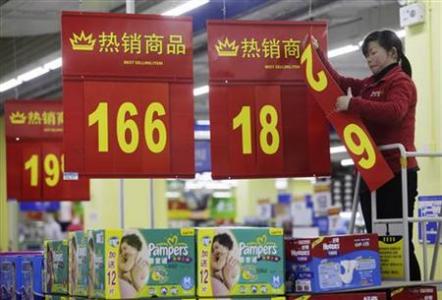(Reuters) – China’s inflation, industrial output and retail sales all flagged in May for a second straight month of sluggish growth that galvanized policymakers last week into taking their boldest action yet to combat a sharpening slowdown.

A flurry of data over the weekend explained China’s surprise cut in interest rates on Thursday – its first since the global financial crisis – by showing the extent of the domestic economy’s weakness. The rate cut followed a number of measures designed to get money flowing back into the economy.
Beijing could offer more support if needed to combat risks from the euro zone debt crisis, which claimed Spain this weekend as the fourth country to seek financial support, and to promote stability in a year of leadership change, analysts said.
“Monetary policy should continue to lean towards loosening,” said Wang Jun, an economist at the government-backed think tank China Center for International Economic Exchange.
Premier Wen Jiabao and other policymakers appeared to be jolted by dire economic figures for April, released a month ago. In recent weeks they have approved languishing investment projects and launched a number of reforms to allow private investment into sectors previously dominated by the state.
Thursday’s quarter point rate cut briefly lifted financial market sentiment, although that gave way to suspicions that the timing of the reduction meant May’s data would be worse than expected. The suspicions were right.
Industrial output rose 9.6 percent in May from a year ago, below expectations and further entrenching concerns the world’s second-largest economy faces its worst slowdown in years.
Retail sales were short of expectations, growing at their slowest pace since February 2011, while investment in the likes of real estate, infrastructure and factories increased at its weakest year-to-date pace in close to a decade.
Consumer price inflation eased to 3.0 percent, below expectations and the lowest level since the middle of 2010.
Producer prices fell 1.4 percent from a year ago, marking the third straight month of producer price deflation.
“The slide in PPI… points to considerable sluggishness in domestic manufacturing activity,” said Xianfang Ren, economist at IHS Global in Beijing.
China is not alone in slowing down. India reported its weakest quarterly growth in nine years and Brazil almost stalled in the first quarter, raising doubts as to how much emerging markets can drive the world economy as industrialized nations struggle with debt.
TRADE SURPRISE
While manufacturing-related data pointed to domestic economic weakness, China’s exports and imports figures were much stronger than expected.
Exports rose 15.3 percent in May from a year earlier, more than double expectations, and up from April’s 4.9 percent rise. A record monthly decline in the yuan against the dollar in May could have helped exports.
Imports gained 12.7 percent, also more than double expectations, and well above April’s 0.3 percent rise. That left a trade surplus of $18.7 billion, the biggest since January.
Some imports may reflect optimism that the China’s stimulus measures will translate into a revival of economic momentum. Copper imports – normally an indicator of economic activity – were surprisingly strong and crude oil imports hit a record high of 6 million barrels a day.
External demand was not nearly as dire either. Exports to the United States rose 23 percent in the first five months of this year compared with a year earlier, the strongest year-to-date pace in 2012.
Shipments to the European Union – China’s biggest foreign customer – grew 3.4 percent on the same basis, the highest since January. The pace of exports to Southeast Asia hit a three-month high.
Still, China cannot count on exports alone. The government has set a more modest target of boosting exports and imports by 10 percent this year compared with the pace of more than 20 percent that characterized 2010 and the early part of 2011.
“The trade situation is still relatively grim,” the official Xinhua news agency paraphrased China’s Commerce Minister, Chen Deming, as saying. “If lucky, we will be able to keep annual growth of around 10 percent.
Concerns are growing that the euro bloc may slip back into recession and even break up. China’s two-way trade with Europe grew by a lackluster 1.3 percent, showing that Europe can’t look to Chinese buyers for much of a boost either.
Reflecting the harder times, some struggling Chinese exporters are offering clients steep discounts in return for bulk orders upfront, trade and investment lawyer Dan Harris of Harris & Moure in Seattle wrote recently in his China Law blog.
Beijing should be ready to launch more stimulus measures to counter “intensifying external weakness”, HSBC researchers said.
“This will be essential for China to avoid a hard landing and for its domestic demand to be upheld,” they said in a note to clients.
SLOWDOWN
China’s economic expansion is widely expected to dip below 8 percent year on year in the second quarter. That would mark the sixth consecutive quarter of lower growth and reflect the sort of pace seen during the trough of the global financial crisis in the winter of 2008/09.
Full-year growth is expected to drop to 8.2 percent, the lowest level since 1999, a Reuters poll showed in May. The government has set a growth target of 7.5 percent for 2012.
Indications abound of a slowdown in the real economy. Crude refinery runs fell 0.7 percent in May from a year earlier, the second straight month of decline and power generation growth was sluggish at just 2.7 percent after its weakest pace in three years in April.
Signs of the domestic economy’s struggle explains Beijing’s heightened concerns. The fall in consumer inflation to well below the official 2012 target of 4.0 percent, meanwhile, gave policymakers room to cut rates, analysts said.
A rate cut tends to affect an economy broadly. Beijing’s previous “fine tuning” policy had included more targeted measures, such as cutting required reserves for banks.
A cyclical drop in pork prices, a staple meat in China, has helped bring inflation down, although fresh vegetable prices remain stubbornly high.
These are key price indicators for policymakers, always sensitive to social stability and more so this year when the Communist Party will select a new leadership.
The transition has already been unsettled by the purge of populist politician Bo Xilai, who had ambitions to be elevated to China’s top decision making body, and the murder scandal surrounding his fall.
Beijing wants to bring real estate developers to heel following a building frenzy sparked by a 4-trillion-yuan stimulus package during the global financial crisis, thereby addressing common people’s complaints that housing prices are too high. But equally it hardly wants a sharp downturn to bring citizens into the streets, analysts say.
Partly reflecting the slowdown in the pace of real estate investment, May’s data showed fixed asset investment grew 20.1 percent in the first five months of the year, the lowest pace in nearly a decade.
(Additional reporting by Shen Yan: Editing by Neil Fullick)





